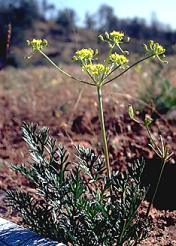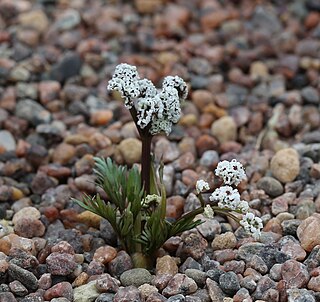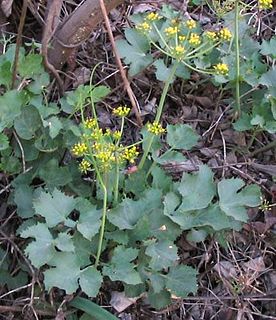
Lomatium is a genus of about 75 species of perennial herbs native to western North America; its common names include biscuitroot, Indian parsley, and desert parsley. It is in the family Apiaceae and therefore related to many familiar edible species such as carrots and celery; some Lomatium species are extensively used by Native Americans in the inland Northwest as a staple food.

Lomatium bicolor is an herb of the family Apiaceae that occurs in two varieties, Lomatium bicolor var. leptocarpum and Lomatium bicolor var. bicolor.

Lomatium macrocarpum is a perennial flowering plant in the carrot family known by the common names bigseed lomatium, biscuit root or bigseed biscuitroot. It is native to much of western North America, where it can be found in various types of habitat, including the grasslands of the Great Plains, and particularly in rocky areas. It is a spreading or erect perennial herb growing up to about half a meter long with hairy, gray-green herbage. The grayish basal leaves are up to about 24 centimetres (9.4 in) long and are intricately divided into many small, narrow segments. The inflorescence bears an umbel of yellowish, greenish, purplish, or white flowers, growing from a lateral stem. The fruit is a compressed, winged, round or oval disc up to about 2 cm long.

Lomatium salmoniflorum is a perennial herb native to the northwest United States. In February and March one to nineteen umbels bloom, each with up to 300 flowers. Each flower is either strictly staminate or hermaphroditic. It has glabrous leaves that are deeply dissected into narrow blades.

Lomatium congdonii, known by the common names Mariposa desertparsley and Congdon's lomatium, is a species of flowering plant in the carrot family.

Lomatium foeniculaceum is a species of flowering plant in the carrot family known by the common name desert biscuitroot. It is native to much of western and central North America, where it grows in many types of habitat.

Lomatium gormanii, with the common names Gorman's biscuitroot and salt & pepper, is a perennial herb of the family Apiaceae. It is endemic to the Northwestern United States, in Idaho, Oregon, and Washington, being found in steppes and montane environments. It is called sasamít̓a, sasamít̓aya, and łałamít̓a in the Sahaptin language.

Lomatium grayi, commonly known as Gray's biscuitroot, Gray's desert parsley, or pungent desert parsley, is a perennial herb of the family Apiaceae. It is native to Western Canada in British Columbia, and the Western United States, including from the Eastern Cascades and northeastern California to the Rocky Mountains.

Lomatium howellii is an uncommon species of flowering plant in the carrot family known by the common name Howell's biscuitroot, or Howell's lomatium. It is native to the Klamath Mountains of southern Oregon and northern California, where it is a member of the local serpentine soils flora.

Lomatium lucidum is a species of flowering plant in the carrot family known by the common name shiny biscuitroot. It is native to coastal mountains and canyons of southern California and Baja California, where it is a member of the chaparral plant community, including recently burned areas. It is found in the eastern Transverse Ranges and the South Coast region.
Lomatium marginatum is a species of flowering plant in the carrot family known by the common name butte desertparsley. It is endemic to California, where it is known from mountains, valley, and grassland habitat, including serpentine, in the northern half of the state. It is a perennial herb growing up to about half a meter tall from a small taproot. There is no stem, and the leaves and inflorescence emerge from ground level. The purple-green leaves may approach 30 centimeters long, their blades divided into many long, narrow segments. The short but wide inflorescence bears an umbel of yellowish, purplish, or reddish flowers. The Lomatium marginatum is not currently an endangered species.

Lomatium martindalei is a species of flowering plant in the carrot family known by the common names Cascade desertparsley and coast range lomatium. It is native to the west coast of North America, from Vancouver Island south to the Klamath Mountains of far northern California. It can be found in a number of coastal and inland habitats, from coastal plains to high mountain talus and meadows. This is a perennial herb growing 15 to 40 centimeters tall from a carrot-like taproot. There is often no stem, the erect or spreading leaves and inflorescence emerging from ground level. The thinly fleshy leaves may approach 20 centimeters long, their blades divided into leaflets made up of many small oval segments. The inflorescence bears an umbel of small yellowish flowers.

Lomatium nevadense is a species of flowering plant in the carrot family known by the common name Nevada biscuitroot. It is native to the western United States and northern Mexico, where it is known from several different habitat types, including sagebrush and woodlands. It is a perennial herb growing up to about 45 centimeters tall from a taproot. The leaves are up to about 16 centimeters long, their blades divided into many oblong pointed segments. The inflorescence is an umbel of white or cream flowers.

Lomatium parvifolium is an uncommon species of flowering plant in the carrot family known by the common names coastal biscuitroot and small-leaved lomatium. It is endemic to California, where it is known only from the Central Coast and central California Coast Ranges. It grows in pine forests and other habitat on serpentine soils.
Lomatium repostum is an uncommon species of flowering plant in the carrot family known by the common name Napa biscuitroot, or Napa lomatium. It is endemic to California, where it is known only from the northrthern California Coast Ranges surrounding the northern San Francisco Bay Area. It often grows in plant communities on serpentine soils.
Lomatium shevockii is a rare species of flowering plant in the carrot family known by the common name Owens Peak desertparsley, or Owens Peak lomatium. It is endemic to Kern County, California, where it is known from only two occurrences at Owens Peak, one of the highest points of the Sierra Nevada. It is a plant of the talus and wooded slopes of the high mountains. This species was discovered in 1984 and first described to science in 1988.

Ranunculus eschscholtzii is a species of buttercup flower known by the common name Eschscholtz's buttercup.

Sagittaria cuneata is a species of flowering plant in the water plantain family known by the common name arumleaf arrowhead or duck potato. Like some other Sagittaria species, it may be called wapato. It is native to much of North America, including most of Canada as well as the western and northeastern United States.
Silene suksdorfii is a species of flowering plant in the family Caryophyllaceae known by the common names Suksdorf's silene, Suksdorf's catchfly and Cascade alpine campion. It is native to the Pacific Northwest of the United States, where it occurs from Washington and Idaho to northern California. It is mainly an alpine species, growing in the talus of high mountain slopes. It can also be found below the tree line in forested subalpine habitat. It is a squat perennial herb producing several erect stems from a leafy, woody caudex. It generally takes a clumpy form. The stems grow up to 10 or 15 centimeters tall and are hairy in texture, with glandular, sticky areas on the upper parts. The leaves occur in tufts around the caudex. They are fleshy and coated in soft hairs. Solitary flowers arise on erect peduncles. Each is encapsulated in an inflated calyx of fused sepals, which is starkly purple-veined and has purplish glandular hairs. The petals are white or purple-tinged and have two lobes at their tips and appendages at their bases.

Lomatium observatorium is a rare species of flowering plant in the carrot family known by the common names Mt. Hamilton desertparsley and Mount Hamilton lomatium. It is endemic to California, where it is known only from the mountains of Santa Clara County, including Mount Hamilton near the Lick Observatory. It may also occur in Stanislaus County. Its habitat includes mountain woodlands on volcanic and metamorphosed sedimentary rock substrates. Described The plant to science as a new species in 1996, the plant is a perennial herb growing low to the ground, the lightly hairy herbage growing from a long taproot.
















